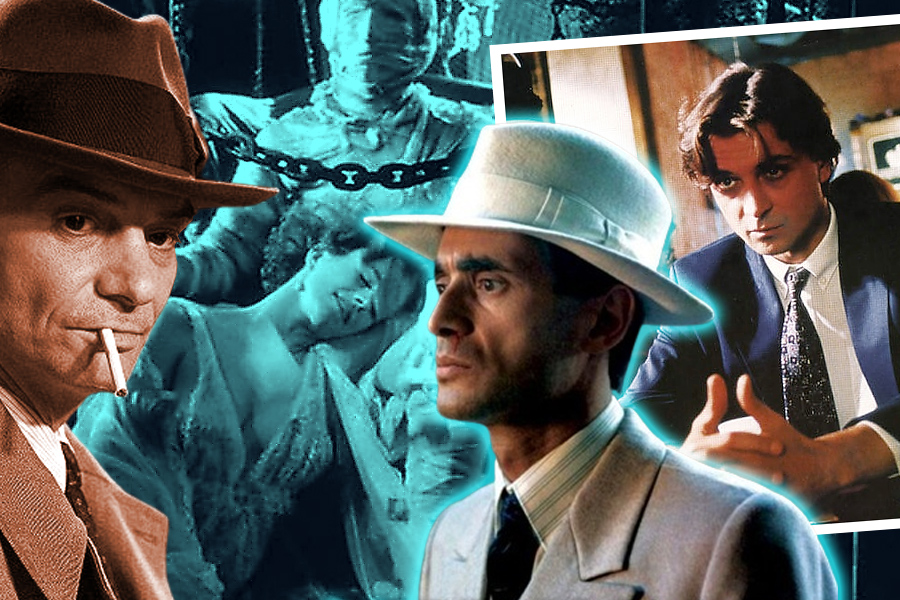Just as the debates over Neil Jordan’s “Marlowe” and Nicolas Winding Refn’s “Copenhagen Cowboy” are settling down, a new season of “True Detective” with Jodie Foster in the lead role is on the horizon. Regardless of what anyone says, noir in all its forms remains highly sought after in today’s era. This review doesn’t aim to provide an in-depth exploration of the genre (or style – debates on what exactly constitutes “noir” persist to this day). No, it’s more of a brief journey into the heart of darkness to uncover a few great “dark films” from Ukraine, Poland, Romania, Czech Republic, Hungary, Bulgaria, and Greece that you might have missed for some reason.
“Man in the Raincoat” (“Un om în loden”), directed by Nicolae Margineanu, 1979, Romania
This paranoid neo-noir, filmed during the era of Ceaușescu, is unfortunately remembered by contemporary film critics much less often than the police commissioner Moldovan’s epic. Although Nicolae Margineanu’s full-length debut, based on the book “Death Comes on Magnetic Tape” by “Romanian John Le Carré” Haralamb Zincă, has many undeniable merits. A 50-year-old geological engineer leading a quiet bachelor life suddenly starts waking up in the middle of the night to the sound of eerie, sardonic laughter echoing in his apartment. At first, he tries to convince himself that it’s just a recurring nightmare, but after receiving anonymous death threats in the mail, he decides to seek help from Securitate agents (the engineer is involved in uranium research, and his safety falls under the jurisdiction of the secret police). The case turns out to be much more convoluted than it initially seems, with one thread of it leading back to the pre-war past, embodied by a sinister old man in a raincoat and black beret. Some of Nicolae Margineanu’s stylistic choices are reminiscent of David Lynch’s “signature ingredients,” even though “Man in the Raincoat” was made ten years before “Twin Peaks.” Suddenly, a bear standing on its hind legs appears outside the city bus window, like an unexpected hallucination; someone is transporting a stuffed animal in the open truck bed. On the street corner, a dwarf tries to reach a mailbox, a live owl that flew in through the window nearly knocks its own taxidermy likeness off the wall, and in the train compartment, the engineer’s fellow passengers turn out to be two middle-aged twin brothers, reinforcing the motif of duality present throughout the film. Securitate agents, with their marked positivity, resemble the “g-men” from American propaganda films of the 1930s – a time when Romanian investigators could afford to drink gin to the tune of “Criminal Tango” (as seen in the 1967 film “Maiorul şi moartea”), a bygone era. The whistle that always precedes the killer’s appearance in “Man in the Raincoat” is either a reference to Howard Hawks’ “Scarface” or a homage to the noirs of the 1940s from the “The Whistler” anthology.
“Medium,” directed by Jacek Koprowicz, 1985, Poland
In Poland, they have always known how to make “dark films,” and they still do. To be convinced of this, one need only recall neo-noirs like Władysław Pasikowski’s “Reich” with its pure “Melvillian” melancholy or the brutal and bleak “Traffic Department” (Drogówka) by Wojciech Smarzowski. However, the wonderful mystical retro-noir “Medium,” shot in the spirit of the famous “Angel Heart” by Alan Parker (right down to the scene with beheading a rooster), rarely makes it into international reviews of this genre. Perhaps this “neglect” is due to the fact that noir is typically expected to have a crime story that stays within the bounds of reality, while “Medium,” as a unique hybrid of “Dr. Mabuse” and “The Tin Drum,” shuns such restrictions. The plot revolves around a female medium and her astrologer brother trying to identify a rival psychic who, on the eve of a total solar eclipse, has started displaying incredible psychic abilities, telepathically controlling four seemingly random individuals and forcing them to commit bizarre acts. One of these four is a police commissioner who is trying to understand why he’s been experiencing memory lapses lately. His investigation increasingly focuses on an old villa, where a bloody tragedy unfolded 36 years ago. The context in which these events unfold is also significant; everything happens in 1933 in Sopot, which, together with Danzig and Gdynia, formed an urban agglomeration with the status of a “free city.” This meant it was a special territorial unit under the protection of the League of Nations and formally did not belong to either Poland or Germany. However, despite the swastika flags seen on the streets of Sopot, the film’s “hypnotic-occult” narrative should not be reduced solely to a sinister allegory of Nazism. Above all, it’s a noir where characters, following the genre’s conventions, attempt to defy an inexorable Fate. Although, as we know (ask Harry Angel or old Oedipus, the Greek king of Thebes), in this struggle, winning is impossible.
“Singapore Sling,” directed by Nikos Nikolaidis, 1990, Greece
Nikos Nikolaidis can undoubtedly be called a “cursed director” (analogous to “cursed poets”). An eccentric, scandalous figure, visionary, and experimenter, whose films were banned both in his homeland and abroad, he remains a marginal figure in European cinema, despite his cult status among cinephiles. “Singapore Sling” is undoubtedly Nikolaidis’s best film and to this day the most stylish and mesmerizing neo-noir in Greek cinema (with all due respect to Yannis Economides’ “Little Fish” (“To mikro psari”), another remarkable representative of the genre). From the very first frames, the viewer is immersed in the atmosphere of “tales from the crypt”: night, rain, an old villa hidden from prying eyes by an overgrown garden; two women – mother and daughter – in mackintoshes worn over their negligees, burying a still-breathing gardener, from whose torn open abdomen organs occasionally spill out. Meanwhile, on the street next to a parked black car, a wounded man in a “Humphrey Bogart” trench coat huddles. He is a private detective who has been searching for a girl named Laura for a long time and has substantial reasons to suspect that the women living in the villa are involved in her disappearance. Soon, the detective becomes a captive of these mad furies, whose life credo aligns with the fantasies depicted in the novel “120 Days of Sodom” (nothing can be done about it – the film “Children of the Devil” (“Ta pediá tou Diavólou”) by Niko Mastorakis, which was banned in all European countries in the 1970s, left a lasting impact on the subsequent generation of Greek directors). Like Christian Petzold’s “Cuba Libre,” another neo-noir with a “cocktail” title, which plays with the plot of Edgar Ulmer’s 1945 “Detour,” “Singapore Sling” is also a unique homage to the “dark classics.” Balancing on the edge between black comedy and a sticky surrealist nightmare, Nikolaidis interprets (or rather, turns inside out) Otto Preminger’s famous 1944 noir “Laura.” While doing so, he retains all the genre’s components – a distinctive black-and-white picture, the weary voice-over monologues of the main character, the endless night, never-ending rain, intricate play of shadows, and a melancholic jazz soundtrack that sounds somewhere beyond good and evil.
“A Friend of the Deceased,” directed by Vyacheslav Krishtofovich, 1997, Ukraine
This is the first film in the history of Ukrainian cinema that was officially submitted for consideration for an Oscar in the category of “Best Foreign Language Film.” Unfortunately, the promotional campaign for “A Friend of the Deceased” was a complete failure, which led to many European film websites still categorizing this film as “Russian” rather than “Ukrainian” (the film was made by a Ukrainian director at a Ukrainian studio but was shot in Russian because, in 1997, Ukraine and Russia were still part of a unified post-Soviet cultural space). Identity issues (national, cultural, existential) were inherent to that time: the Soviet empire had collapsed, old “rules of life” no longer applied, and new ones were still forming. Party and Komsomol leaders became criminal bosses, former KGB officers became gatekeepers of business, and representatives of the so-called “technical and creative intelligentsia” became destitute. The film’s main character is one of the latter: no money, no job, his wife leaves him for a wealthy lover, and despair is knocking on his door like the Commandant from “Don Juan.” In a drunken frenzy, the protagonist orders the murder of his wife’s lover over the phone, but at the last moment, he puts his own photo in the envelope instead, because he’d rather die than endure such a pitiful existence. On the same day, he unexpectedly receives a large sum of money – it’s his fee for providing false testimony in someone else’s divorce case. Now, the protagonist wants to live again, but canceling the hit is impossible, so he has to hire another hitman to eliminate his “colleague.” If up to this point, the plot of “A Friend of the Deceased” resembled “Der Mann, der seinen Mörder sucht” by Robert Siodmak or “I Hired a Contract Killer” by Aki Kaurismaki, then afterward, it turns into a schizophrenic noir in which yesterday’s victim takes the executioner’s place, marrying his widow, adopting a child, and inheriting the “business.” In essence, “A Friend of the Deceased” is a story of a doppelgänger. It’s also a recollection of a strange time when cognac was served with a slice of lemon, prostitutes had golden hearts, and human life was worth $350.
“Zift,” directed by Javor Gardev, 2008, Bulgaria
Bulgarian cinema is not often associated with a fondness for noir aesthetics. Only “Inspector and the Night” (Inspektorat i noshtta) by Rangel Vulchanov lightly flirted with the “dark film” in 1963, surprising the audience with a character who was a “cynic with a good heart and bad manners” who occasionally broke the “fourth wall.” The shock was all the greater when “Zift” was released, shaking not only the neo-noir genre but also the stereotypical perception of Bulgarian cinema, which for many people usually amounted to spy films starring Emil Boev. The unusual title of the film is explained right away: “zift” means both “tar,” which was used during the heyday of socialism as a substitute for chewing gum, and a slang term meaning “crap.” In a nutshell, the plot seems conditional and banal: a thief nicknamed “Moth” is falsely accused and sent to prison in the early 1940s when Bulgaria was still under monarchy rule. He is released in the early 1960s when communism has taken hold. Simultaneously with Moth’s arrest, a large diamond goes missing, so his former partners start hunting him down as soon as he exits the prison gates. In “Zift,” there are nods to classic noirs (Moth’s former lover, now a singer in a café, performs “Put the Blame on Mame,” imitating Rita Hayworth from “Gilda,” and Moth, like Edmond O’Brien in “D.O.A.,” discovers that he has been poisoned and has very little time left to live). There are also “Tarantinoesque” passages, such as stories about three tons of feces dumped by a jealous sewage worker into his wife’s lover’s apartment or about women from a sewing factory whose heads were chopped off with an iron sheet at the hair salon while they were getting ready for International Women’s Day. But despite all this postmodern irony, “Zift” remains a genuine fatalistic noir in which even the toughest “hard-boiled” guys succumb to the cunning of the femme fatale.
“In the Shadow” (“Ve stinu”), directed by David Ondricek, 2012, Czech Republic
The Czech cinema began to explore noir aesthetics roughly around the same time as American and French cinema did. In 1946, Martin Fric directed “Precinct 13” (original title: “13. Revír,” not to be confused with John Carpenter’s “Assault on Precinct 13”), which can be described as a “noir emerging from Commissioner Maigret’s overcoat.” Neo-noir in the Czech Republic has also been thriving, with films like Zdenek Viktora’s “Raluca,” featuring a private detective with a Chandleresque name, Philip Marold, falling in love with a fatal beauty reminiscent of Hazel Brooks, garnering significant attention. However, the calling card of Czech “dark cinema” for the last decade has been the retro-noir film “In the Shadow.”
Set in 1953 in the Czechoslovak Socialist Republic during the height of political purges under Klement Gottwald, the film follows a Prague police captain as he takes on a jewelry theft case, solving it incredibly quickly, within a matter of hours. All evidence points to the safe being cracked by a former criminal and Auschwitz survivor, now a quiet alcoholic who lives peacefully within the Jewish community. However, the evidence seems too obvious to the captain, and an alibi is found for the accused (though only after he “confesses” in full). The captain’s experience and instincts tell him that beneath this fabricated case lies a more profound and sinister conspiracy, one possibly involving state security personnel and a mysterious German officer with an SS tattoo. While he could close the case by accepting the official version, the captain is determined to uncover the truth at all costs. Above Prague, red flags flutter, the city’s walls bear portraits of Stalin, and the city grapples with both anti-Semitic hysteria incited by the Kremlin after the “doctors’ plot” and paralyzing fear of an impending monetary reform. The captain, despite facing numerous obstacles and a rising body count, persists in his quest for truth, turning the film into an anti-totalitarian tragedy.
“Budapest Noir,” directed by Eva Gardos, 2017, Hungary
Noir aesthetics have always been close to Hungarians. After all, the Hungarian composer Rezso Seress wrote one of the most iconic “noir” songs in the world in 1933, titled “Gloomy Sunday,” which was performed by Billie Holiday, Bjork, and Portishead. Hungarian cinema has also maintained this affinity for noir, with films like Ferenc Andras’s hauntingly fatalistic “The Vulture” from 1982 or Gyorgy Feher’s somnambulistic “Twilight” from 1990, reminiscent of “True Detective” on sedatives. However, today, the calling card of Hungarian “dark cinema” is the relatively recent “Budapest Noir,” adapted from Vilmos Kondor’s novel of the same name.
This retro-noir is set in Hungary in 1936, during the rule of the pro-Nazi Admiral Miklos Horthy. Mass gatherings were banned, although an enormous crowd attended the funeral of Prime Minister Gyula Gombos, which marks the film’s beginning. Anti-Semitic sentiments begin to take on the character of mass hysteria. A crime reporter from a Budapest newspaper arrives at the scene of a prostitute’s murder and recognizes the victim as the mysterious stranger he recently had lunch with. Furthermore, he had seen her photo in the office of one of the police chiefs. The police try to bury the case, attributing the murder to the fact that the victim was Jewish, and thus, no one cares about her death. However, when the victim’s body mysteriously disappears from the morgue, the journalist and his photographer girlfriend embark on their own investigation, encountering the typical obstacles of the genre. “Budapest Noir” lives up to its name: it features corrupt cops, brutish gangsters, debauched politicians, fatal women, and a city caught between two world wars, unraveling the dark corners of human sin. But for Eva Gardos, it’s not just about showcasing her knowledge of the genre’s conventions but also drawing parallels between Hungary in 1936 and the ideological direction taken by the modern Hungary under Viktor Orban’s leadership.
Source: The Gaze







